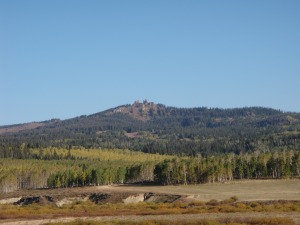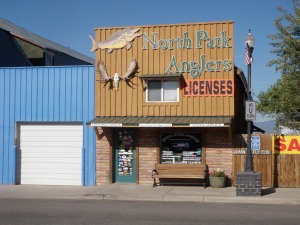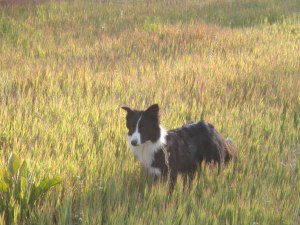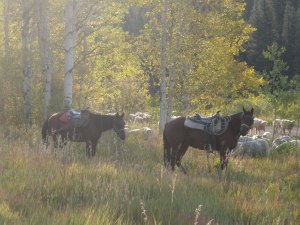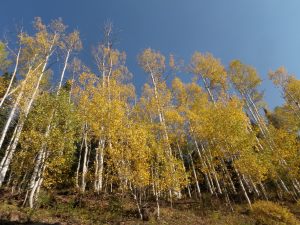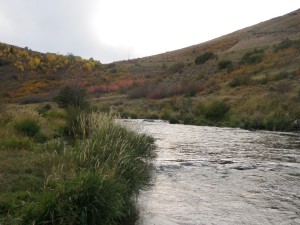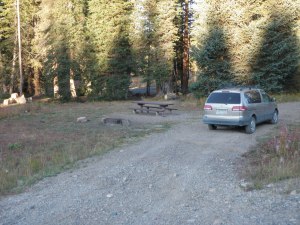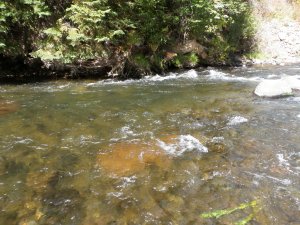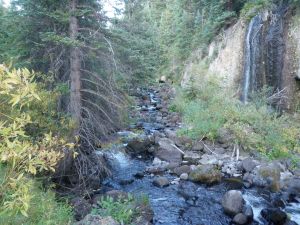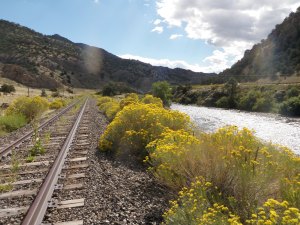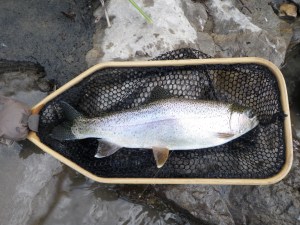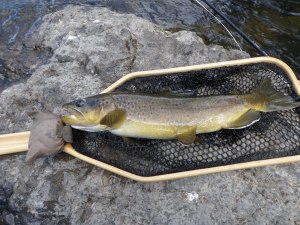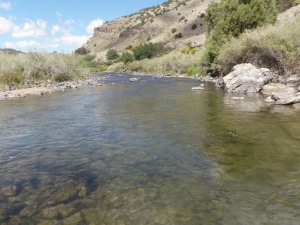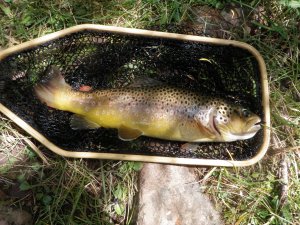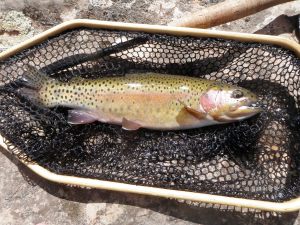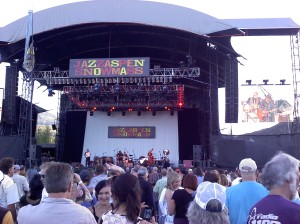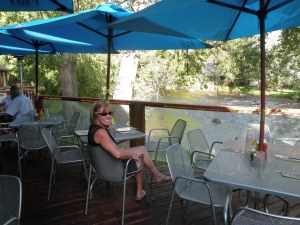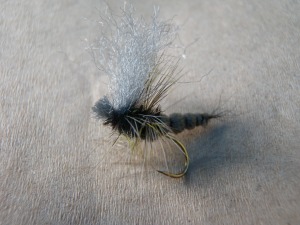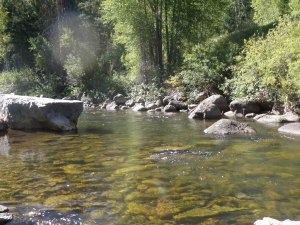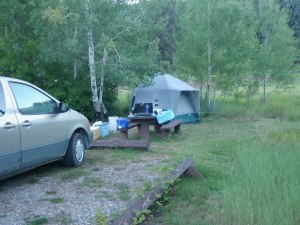Time: 11:00AM – 5:30PM
Location: End of path on west bank where canyon narrows and bend with three homes on the hillside
Fish Landed: 13
North Platte River 09/16/2010 Photo Album
When I awoke on Thursday morning I was indeed the only camper at Dumont Lake. It was kind of an eerie feeling. I quickly ate, washed up and packed everything back in the car and continued my journey to North Park. I stopped and took some photos of the rabbit ears on Rabbit Ears Pass then continued north into North Park to Walden. I stopped at the North Park Anglers Fly Shop in Walden and talked to the proprietor. He gave me detailed directions to the parking lot at the entrance to Northgate Canyon on the North Platte River. He told me make sure you hike in a ways. “The fishing gets better the farther you go.”
I asked about hatches, and he said there were tricos in the late morning, and BWO nymphs were active in the afternoon. He actually said “the canyon is on fire”. At his suggestion I bought his last four sunken tricos plus two beadhead cdc baetis nymphs. With these added to my arsenal and an optimistic outlook I drove another 15 miles to the parking lot at Northgate Canyon. Since I was going to hike a ways, I loaded all my fishing gear in my blue backpack and hiked the trail in my sneakers and jeans. This would prove to be a bit of a mistake.
Initially I was flying on the path, but after a half mile or so the path y’d with one leg going down to the river and the other climbing up the steep bank and over a large rock. I tested the path to the river and realized waders were required, so I reversed and stayed on the steep dirt path. I caught up to another fisherman who told me his two buddies were wading down the river and making better time than him. I told him I didn’t think it was possible to wade faster than walk on a path, but eventually I was proven wrong. I continued to struggle on the rough sloping path until I reach a place where a huge vertical rock wall blocked my path on the west bank, and I was forced to put on my waders and cross to continue down the river. The two buddies of the fisherman I passed were visible downstream from my position, so I decided to put on my waders, stash my backpack and fish back upstream from where I was for the next hour or two until I ate lunch.
The Chernobyl ant, beadhead hares ear, and beadhead RS2 remained on my line from Wednesday on the Yampa, so I stuck with the threesome. In a short amount of time I hooked and landed a couple small rainbows after I crossed to the east side of the river. The water I was fishing was very nice with deep pools among large boulders. I worked my way up the left side and landed a couple medium sized browns. Each move upstream brought me to water that was a bit shallower as the river bed spread out. Eventually at around the fifth pool, I encountered an ideal stretch of water with nice runs and riffles around in-stream boulders and water depth of three to four feet.
At this point I’d landed eight fish with several on the beadhead hares ear and the remainder on the RS2. A few of the eight fish were landed at the bottom of the ideal section of water I was currently casting to.
The first thing I noticed when I reached the river were the dense clouds of tricos above the riffles. It was now around noon and strong gusts of wind would occasionally push the trico cloud downstream and above my head. I began to notice sporadic rises, so the tricos seemed to be hitting the water. I quickly opened my fly pouch and plucked a sunken trico then snipped off the RS2 and tied on the trico. I cast this combination to the area I’d seen rises and saw the Chernobyl dip. A hook set response caused me to feel the weight of a decent fish. I fought it back and forth a few times and netted a nice fat brown of around 15 inches. I waded to a nearby rock and rested my rod while I pulled out my camera and then placed the brown on the net on the rock to photograph. But the brown began to flop, and before I could contain it, it got in the water and broke off and stole my sunken trico.
I had three sunken tricos left, and I continued to see rises. I tied another one on and cast to the area of more rises. Wham! A fish grabbed the trico and took off upstream ripping line quickly from the reel. Have you ever noticed some of your fly line looped behind the reel where it attaches to the butt of the rod? Well I noticed this was the case now, but it was too late the line stopped spinning off the reel, but the fish continued and, ping, another sunken trico was lost to a fish.
I found a third sunken trico in my foam pocket and attached it as my third fly. I cast again to the top of the attractive section of water, and once again after a few casts, the Chernobyl dipped and I set the hook and was attached to another nice brown. This one was smaller than the first, and I successfully landed and photographed the brown. This would prove to be the last fish before the trico action died back, and I waded back to the west bank and returned to my backpack for lunch.
The fly shop person’s words continued to play through my head, “The farther you go, the better the fishing.” After lunch I waded back to the east bank and began hiking downstream. There was actually a pretty decent path, and I followed it for perhaps a mile. This probably proved to be a strategic error, but I chalk it up to a scouting expedition. I bypassed some very attractive water in the first .2 miles of where I crossed. There was another shorter stretch of nice water within .5 miles. After that the river was very wide and shallow for quite a distance. I passed by this water and targeted a bend in the river with three or four cabins on the hillside before the bend. The main current ran against the west bank and there were numerous boulders protruding near shore.
This water was fair, but in retrospect, not nearly as attractive as the section I fished in the morning and the sections I passed by. There was very little structure and I had to blind cast to a lot of area. It didn’t take long, however, before a small rainbow grabbed the RS2. Shortly thereafter, the Chernobyl plunged a couple times and I hooked fish that felt heavier, but these ended up being long distance releases from the small RS2. After this flurry of action, I began to notice some sporadic rises, so I switched to a CDC BWO, but this proved fruitless. I saw a few small mayflies dancing on the water when the rises occurred so perhaps my fly was too large or didn’t match. I should have tried the sunken trico, but it’s too late now.
Eventually I switched back to the RS2 and when I got to the last decent riffles above the rocks along the west bank, a fish aggressively grabbed one of my submerged flies and raced away. I pressured the fish back and forth until I could see it was a large rainbow clearly in the 15-20 inch range. When the rainbow was 15 feet above me, I counted number 12 in my head, but it made a sudden spurt downstream and swam right between my legs. I should have grabbed my net and put it between my legs, but I didn’t have enough presence of mind. The Chernobyl hooked into the neoprene gravel guards on my waders and the monster rainbow was free.
I crossed back to the east bank and hiked back up the path beyond the wide shallow barren water and eventually reached the two sets of attractive water below my lunch spot. The water was now in shadows from the steep canyon walls and it was between 4 and 5PM. I managed to land a couple small rainbows in the riffles, but lost my ambition and decided to cross back, gather my backpack, and head back to the car and then to Denver for a hot shower and a good night’s rest.
I caught up to one of the threesome that hiked in ahead of me, and he was positioned in the ideal water I’d fished just before lunch. He told me he’d been in the same spot most of the afternoon and hooked at least fifty fish, but didn’t land them all. He suggested that the spot held an infinite number of eager fish. He was throwing a beadhead nymph with a non-beadhead RS2 and a yarn strike indicator.
I can only dream about fishing the attractive rocky riffle water in the afternoon and running the RS2 deep through the pools and runs with a swinging motion and lift at the end of the drift. It will happen on another day.

